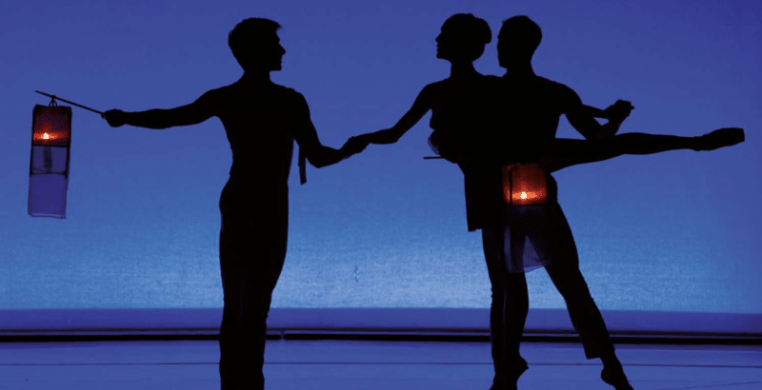On Feb. 10th, Madrid-based Compañía Nacional de Danza (National Dance Company) made its Chicago debut at the Auditorium Theatre, showcasing a mesmerizing series of performances that explored the intricate layers of human existence. The carefully selected pieces presented the company's choreographic history while guiding the audience through an emotional journey of connection and loss. In an interview with See Chicago Dance, Artistic Director Joaquin De Luz and the company artists provided new insight into the work.
Artistic Director Joaquin De Luz, a former soloist with the American Ballet Theatre and principal dancer with the New York City Ballet, programmed the pieces with the intention of making sense "musically… and stylistically." He added that he “like(s) to take the audience on a journey…I like everybody to have something unique… that they can take home. This program is very diverse in style, music,… and even in heaviness. But there's a common thing that unites the three pieces… and it is humanity… It's three visions, three choreographers.”
The first piece, "Passengers Within," choreographed in 2022 by Joaquin De Luz himself, draws inspiration from societies' entanglement with systems of modern technology. When talking about his own piece, De Luz was very humble about his status as a choreographer and emphasized how new he is to the craft compared to the talent he works with; however, the warm reception to his piece seems to prove his talent for the craft.
He confessed that its creation was an exercise for the company in “dynamism, syncopations, and musicality” and was taken aback when the opening reactions were overwhelmingly positive. Since its initial inception, the piece has continued to evolve with the help of its company members, which improves the focus of the performance and validates De Luz’s claims that this piece will forever be a “work in progress.”
De Luz also highlighted the significant influence of Philip Glass's music, describing it as a source of "incredible inspiration.” He stated that the music “gives you a sense of time and space and movement like no other” and further joked that “if my choreographer is bad, maybe people can just close their eyes and be moved anyway.” However, no one was able to take their eyes away from this potent piece when the tour finally reached Chicago’s shore.
Prima Ballerina Kayoko Everhart also shared her perspective as one of the twelve dancers performing the piece, describing the movement as “very big and free” but difficult to execute. She described De Luz’s choreography style, saying that “find[ing] freedom within is complicated, it’s very fast choreography for pointe shoes.” She humorously added that this is why the piece only “feels great when I'm in shape.”
But a balance was ultimately able to be accomplished between “a nice challenge” and “choreography… made just for you” due to the dancers themselves taking part in the choreographic process. The performance has continued to evolve into a blending of new ideas and perspectives which validates De Luz's claim that his piece will always be a work in progress.
 Yaman Kelemet and Felipe Domingos of Compañía Nacional de Danza
Yaman Kelemet and Felipe Domingos of Compañía Nacional de Danza
“Sad Case” choreographed in 1998 by Sol León and Paul Lightfoot stands out among the duo’s lifespan and showcases the grounded movements of mambo dance infused with a playful and witty atmosphere. Described as a “very detailed and theatrical” performance, the piece surprised viewers with its quick and humorous movement. The work featured five dancers stuck in a continuous search for tension between satirical and classical moments and elicited incredible reactions from its Chicago audience that left them prepared for what was to come.
“White Darkness” choreographed in 2001 by Nacho Duato is the heart-wrenching, soul-crushing piece of the show. Described as a “true masterpiece” by both De Luz and Everhart, the performance unfolds the deeply personal narrative of Nacho’s own experience as he grappled with the loss of his sister to a cocaine addiction.
Everhart called it “beautiful” with an “emotional element … [that] add[s] this layer of depth. And… the music choice is just so moving. Every element kind of came together.” She described Nacho as a huge inspiration for her growing up, and her main motivation for moving to Spain from the US. She described his choreographic style as “a perfect combination of… ballet technique, [and]… all of this freedom in the movement” which she claimed fit her dancing style “like a glove.”
Everhart used to daydream about doing the main role within “White Darkness,” and she has now performed three of the four core Corpse de Ballet couples as well as earning the main couple role for this tour. She describes the experience as “very special” and proved to Chicago audiences that she and this company are an emotional force not to be reckoned with.
The conclusion to this piece was a visual feast for the eyes that left audiences breathless. Soft white powder descended from the ceiling engulfing Everhart until she became consumed by her addiction. Left swimming in a sea of white, this heartbreaking yet hopeful ending is part of the reason De Luz and Everhart expressed their profound connection with the piece's conclusion. Chicago audiences were left shaken and forced to reflect on the performance's potent themes of addiction and loss.
While only performing for one evening on Feb. 10th, the Compañía Nacional de Danza left a memorable mark on the Chicago dance scene as they showcased some of their most remarkable works to date. The Auditorium Theatre helped facilitate a dialogue between different languages through the universal experience of being human, a huge step in opening the door for other international choreographers and dancers to share their artistry with the United States.
For more information about Compañía Nacional de Danza, click the link below.

